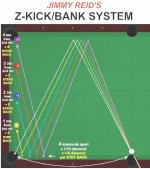One third the length of the playing area = 2 2/3 diamonds, so on your table at that starting angle the shot works just about on the "equal angle" path.On my GCII, "Z" kicking two rails corner to corner requires aiming about 2 1/2 to 2 3/4 diamonds up on the first rail. It is a dead ball kick when aiming there
I wonder how much each rebound angle differs from equal angle (i.e., where the CB contacts the 2nd rail).
I also wonder how things change at different starting angles. I'd guess that the amount the second rebound shortens up increases as the starting angle gets steeper, but begins decreasing again after a point (45 degrees?).
pj
chgo
